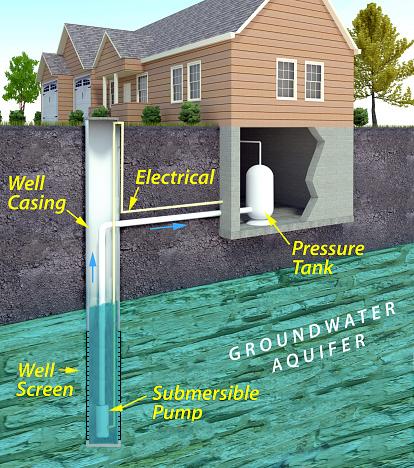 Drilled wells are constructed by percussion or rotary-drilling machines. Drilled wells can be thousands of feet deep and require the installation of casing. Drilled wells have a lower risk of contamination due to their depth and use of continuous casing. 1. Well descriptions adapted from the U.S. Geologic Survey, Groundwater Wells (2016) Well Components
Well component descriptions adapted from the National Ground Water Association (2017) Well Location & Construction Proper well location and construction are key to the safety of your well water. The well should be located so rainwater flows away from it. Rainwater can pick up harmful bacteria and chemicals on the land’s surface. If this water pools near your well, it can seep into it and potentially cause health problems. The Center for Disease Control (CDC) has an excellent web page on well siting. Appropriate well construction depends on local geologic and groundwater conditions. Your state water-well contractor licensing agency, your local health department, or a local water system professional can provide information on proper well construction. The National Ground Water Association (NGWA) provides a guide for hiring a water system professional that covers key considerations.
11 Comments
It really helped when you said that submersible pumps are the ones usually used for deep private wells, since they will be placed inside the well casing and connected to the power source. I will consider this for the water well pump installation we wanted for the property we bought this year. We plan to have one installed before we move into the property so that we have other sources to save money in the long run, especially with the rising costs of supplies these days.
Reply
9/27/2022 10:29:32 am
I appreciate what you said about how deep wells need submersible pumps because they can be connected to the power source. My brother just inherited a home with a big well but the pump doesn't seem to be working. The well is really deep so he wants to get the right kind of pump to handle it.
Reply
11/2/2022 04:19:25 pm
Thanks so much for explaining how home wells work and each component. My sister has a well on her property but the pump she has is broken. We've been looking into finding some professionals to help her replace it with a newer one.
Reply
11/2/2022 04:21:27 pm
My favorite part is when you said that well casing provides a big role in protecting the ground for the proper function of well pumps. The other night, my friend informed me they were planning a new well pump installation on their property for a reworked and clean function of their well. He asked if I had any thoughts on the best option for consulting a well-service company. I'm thankful for this helpful article. I'll tell him it will be much better if they consult a trusted well pump service as they can help provide information.
Reply
1/18/2023 04:35:18 pm
I appreciate when you explained that the jet pumps are the most commonly used option for shallow wells that are 25 feet or less, since it is mounted on the ground and uses suction to draw the water. I will mention this to my husband so that we have an idea of what water well pump to get when we hire contractors this year. We would just like to have another source for our home to reduce our monthly expenses in the long run, since the rates are constantly increasing as years go by.
Reply
2/27/2023 09:03:13 am
I found it interesting when you said that a power source could be connected to the well pump for efficient function. My uncle told me the other day that they planned to have a new water well pump installed in their home because their existing well pump is having problems with pressure. He asked if I had any idea what would be the best option to do. Thanks to this helpful article, I'll tell him it will be much better if they consult a trusted water well pump installation service as they can provide more information about the installation process.
Reply
5/17/2023 02:22:21 pm
It's good to know that the most commonly used pumps are jet pumps. My husband and I want to get a well drilled on our property this summer, so I wanted to make sure we knew how to choose the right pump for it. I appreciate you helping me learn more tips on choosing the right water well pump.
Reply
7/25/2023 11:43:22 am
It's great that you explained that submersible pumps are mostly used in deep private wells. My friend told me that their well needs a reliable pump. I should advise him to look for a plumber that provides quality well pumps.
Reply
9/8/2023 01:00:39 am
The well screen is another name for the bore screen. This is a piece of the main pipe that typically sits in the driller's discovered groundwater at the bottom of the bore. Additionally, it strengthens the bore casing and stabilizes its circular shape. This has holes that allow subsurface water to flow into the pump and be transported to the surface. These are often made of PVC pipes, just like the casing. These are made of stainless steel mesh for heavy commercial applications, allowing for large groundwater flow rates.
Reply
1/23/2024 01:47:36 pm
It stood out to me when you mentioned that drilled wells can be thousands of feet deep. It seems like it would be important to know what kind of layers of rock you have to drill through when creating a well. Working with a drilling company seems like a good way to create a deep well.
Reply
Leave a Reply. |
